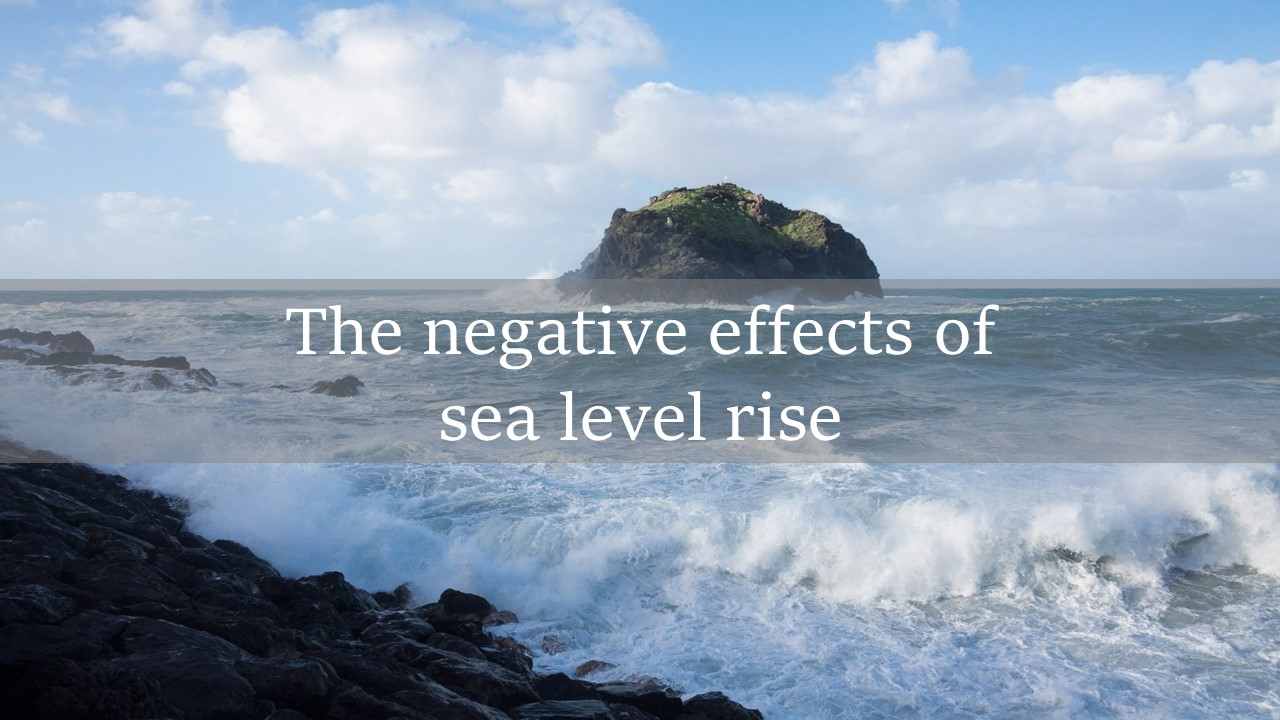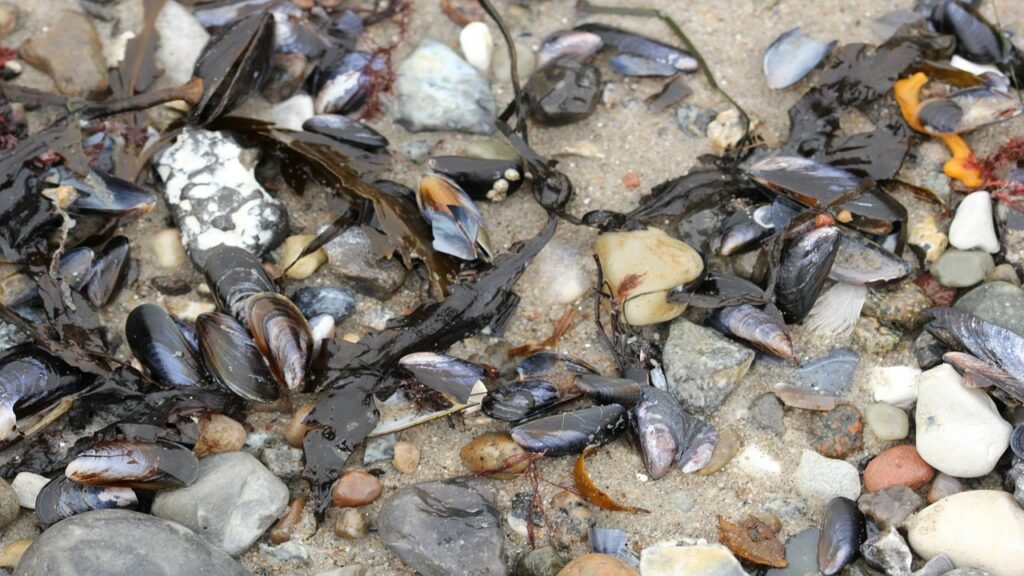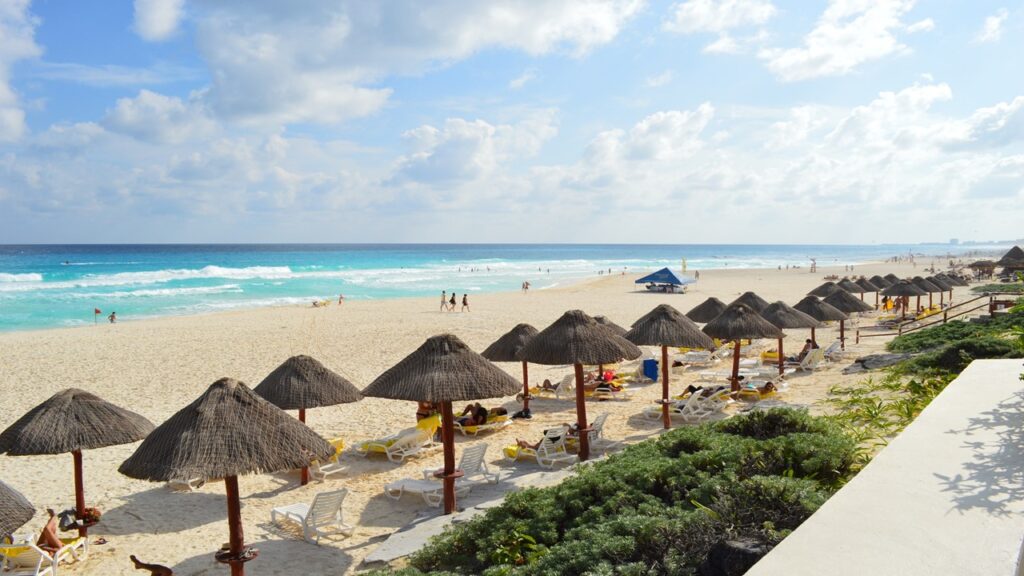Negative effects of sea-level rise

Sea level rise will undoubtedly have drastic effects on coastal nations and assets.
UN Secretary-General Antonio Guterres referring to Tuvalu says ‘Rising sea levels threaten to drown this island nation – a sign of what’s in store for us all.’
Around 680 million people currently live in low-lying coastal regions, a number that is expected to surpass one billion by 2050. Currently, coastal flooding is becoming quite common in many regions of the world like Bangladesh, India and the United States. In others, coastal agriculture is severely at risk especially in the wetlands of southeast Asia where 88% of the world’s supply of rice grows.
Rising sea levels
Research by the IPCC highlights that the sea level rose from 1.4 mm yr-1 in the early 1900s to an alarming rate of 3.6 mm yr-1 in 2015. What’s more, it is very likely that 95% of the world ocean will rise by 0.29 m and 1.1 m by the end of the 21st century. Similarly, 70% of coastlines is expected to experience a sea-level change within 20% of the global mean sea-level change.
Thus, coastal regions, low-lying islands and the SIDS (Small Island Developing States) will suffer tremendously from such encroaching waters.
Negative effects of sea level rise
1. Coastlines will retreat due to sea-level rise
Quite obviously, sea-level rise will lead to a retreat in coastlines. That is, coastal regions and beaches will vanish. As the water level rises, it will cover more land thus decreasing the size of coasts.
Throughout the history of the Earth, the coastlines receded and advanced several times due to natural processes like sea-level rise or land subsidence. The last marine transgression some 18 000 to 6 000 years ago caused the world’s coastlines to retreat because of climatic warming [1]. Some 6,000 years ago this marine transgression stopped except on subsiding coasts thus forming rich estuaries and deltas.
With today’s anthropogenic climate change, coasts are disappearing as the sea eats away expanses of land. Mauritius for instance lost some 20 m of its beaches during the past decades as a result of the rising sea level.
2. Sea level rise will destabilize coastal ecosystems
Basically, various ecosystems like salt marshes, mangrove forests, coral reefs etc. make up the coastal and marine environments. Whether directly or indirectly, sea-level rise will in fact affect them.
In mangrove forests for example, as the sea level rises, mangrove trees will not be able to cope with the increasing salinity. As such, mangrove forests may shift landwards.
But, man-made structures like dykes, houses and infrastructure may restrict their movement. At the same time, the germination rate may also decrease in mangroves as more seeds die than sprout.
3. Considerable ecological changes may occur
What’s more, as the sea level rises, some coastal habitats within particular zones may altogether disappear.
For instance, in North American bays, some 20-70% of intertidal habitats may disappear altogether in the coming 100 years. This is because the land is quite steep and there are many artificial structures in place like sea walls. These will thus prevent wetlands to migrate towards the land.
Additionally, if the sea level increases faster than certain species can grow, some habitats like coral reefs may become smaller [2].
In addition to that, some researchers propound that sea-level rise may push saline water upstream rivers. As an example, a 1 m sea-level rise would push water up to 80 km upstream the Gorai River network in Bangladesh [3].

Photo by 117059 from Needpix
4. Coastal flooding will impact heavily on settlements and infrastructure
As it currently stands, more than 600 million people live in coastal regions that are less than 10 m above sea level. Additionally, approximately 2.4 billion people live within 100 km of the coast.
As the sea level increases, it combines with other physical factors like waves, winds, tides and currents. All these eventually result in temporary or permanent flooding. In San Francisco Bay, for instance, research shows that a small rise of 30 cm in sea level would cause 100-year-floods to occur every 10 years.
Therefore, coastal flooding will heavily impact settlements and infrastructure in place. It will damage and destroy properties and require more frequent repair and maintenance. In certain cases, essential service and transport may be interrupted.
5. Contaminate groundwater
One of the most serious consequences of sea-level rise is that it contaminates groundwater. Saltwater slowly infiltrates the ground and mixes with potable water as the sea level moves further inland. Basically, if 1% seawater contaminates freshwater, it becomes unfit for human consumption.
This can lead to water crises in places with high temperatures and where water is already scarce. As a result, agriculture and farming will become quite challenging on coasts.
To illustrate this, saltwater intrusion (among other reasons) has badly affected coastal agriculture in Bangladesh. Consequently, the production of many vegetable species plummeted and one local paddy species even perished.
6. Increase transmission of diseases
In the same way, rising sea levels will also increase the transmission of diseases. This is because more water on land will create more wetlands where disease-causing vectors can proliferate. Examples of such vectors are mosquitoes, aquatic snails and sandflies.
In fact, until the mid-20th century, we disdained and filled wetlands mainly to control mosquitoes [4]. Though now we understand how wetlands are important, the public health profession still disregards them.
Research shows that mosquitoes that bred in marshes transmitted the West Nile virus along the Indian River Lagoon. Likewise, wetland snails spread schistosomiasis (snail fever) to many people in South Africa. And cholera spread in Bangladesh through mangroves and estuaries.

As the sea level rises, more wetlands form thus increasing disease transmission
Photo by Egor Kamelev from Pexels
7. Economic repercussions of sea-level rise
As a matter of fact, the major economic centres of the world such as London, Shanghai, Lagos and New York are on the coast. These cities are densely populated and packed with facilities. For example, in China, 11 coastal provinces covering just 13.5% of the land account for 57.4% of the national GDP. In the SIDS almost all of the economic centres, sea and airports are on the coasts.
Thus, as these regions are economically important, analysts examined the potential impacts of sea-level rise on coastal assets, property and building structures. So, let’s take the US National Assessment of the coastal sector alone. The cumulative estimates of impacts are at roughly $20 to $200 billion for a 46 cm rise by 2100.
Trade and commerce
Similarly, as the sea level rises, it will also affect trade and commerce. This may cause more people to migrate inland. Or it may discourage people to move to coastal regions due to coastal flooding and closed businesses.
What’s more, rising sea levels may worsen coastal storms and disasters thus decreasing the ease of export and import. This will invariably transmit to whole countries and impact heavily on nations.
8. Heavily affect coastal tourism
Likewise, coastal tourism that relies on the ‘sun, sea and sand’ image is greatly at risk. Not only will the number of coastal tourists decline, but we might lose coastal infrastructure as well.
In fact, research into sea-level rise shows that sea-level rise will flood as much as 29% of the tourism associated assets! And the cumulative effects of storm surge and extreme events will damage about 49% of assets.
Taking Barbados as an example, 70% of the hotels are located within the 250 m high watermark level. Subsequently, a 1 m rise in sea level will invariably cause a lot of damage to hotels and assets.

9. Reassesss international water and high water marks
One issue of international importance regarding global sea-level rise is about land sovereignty.
As the sea level rises and encroaches on the land, coastal jurisdictions will change. Member states of the UNCLOS will thus have to re-partition and re-assess the international seas to prevent conflict of interest.
Similarly, individual nations will have to reassess their high watermarks and flooding zones. This will be critical before any development project or implementing adaptation measures.
10. Forced relocation
Regrettably, as sea levels increase, certain regions that are already subsiding will lose large expanses of land. We notice this especially in the Pacific islands like Tuvalu. The land is sinking while the sea level is rising.
As storm surge and extreme sea events add to the problem, the coast becomes inhabitable. Consequently, people have to relocate inland where the land may be already saturated. For low-lying islands, whole nations could lose their homelands.
In fact, the fifth assessment report of the IPCC reveals a dark future for many small island states like Kiribati, Marshall Islands and Micronesia. High sea levels and recurrent swells may make these islands inhabitable within a few decades only.
The bad news about sea level rise
Thus, the negative effects of sea-level rise include the receding of coastlines, a destabilization in coastal ecosystems whereby considerable ecological changes may occur, coastal flooding, contamination of groundwater, an increase in the transmission of diseases, threats to coastal economy and coastal tourism, the reassessment of international water and high water marks and forced relocation.
Conclusively, sea-level rise is a direct threat to many coastal nations, especially the small remote islands. Due to their small size, most of the settlements, infrastructure and agricultural lands are on coastal borders.
For the low-lying atolls with a land area within 5 m above sea level, the impacts of sea-level rise are quite significant. Thus, most coastal nations are coming up with plans and strategies to decrease the coastal impacts associated with sea level and keep the sea at bay.
References
- Bird, E.C., 1996. Coastal erosion and rising sea-level. In Sea-Level Rise and Coastal Subsidence (pp. 87-103). Springer, Dordrecht.
- Harley, C.D., Randall Hughes, A., Hultgren, K.M., Miner, B.G., Sorte, C.J., Thornber, C.S., Rodriguez, L.F., Tomanek, L. and Williams, S.L., 2006. The impacts of climate change in coastal marine systems. Ecology letters, 9(2), pp.228-241.
- Hong, B., Liu, Z., Wu, H., Gong, W., Xu, H. and Wang, D. (2020). Potential physical impacts of sea level rise on the Pearl River Estuary, China. Journal of Marine Systems, Sciencedirect, 201, pp. 1032454.
- Dale, P.E.R. and Connelly, R., 2012. Wetlands and human health: an overview. Wetlands ecology and management, 20(3), pp.165-171.

Pingback: Effects of Droughts: Positive, Negative, Examples - Yo Nature
Pingback: Why islands must protect their mangroves - Yo Nature
Pingback: 7 reasons Why the Global sea level is rising - Yo Nature
Pingback: Positive effects of sea-level rise - Yo Nature
Pingback: Flooding Explained: Types, Causes and Examples - Yo Nature
Pingback: Sea level rise Mauritius: Relocation as a prospective solution - Yo Nature